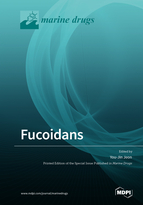Fucoidans
A special issue of Marine Drugs (ISSN 1660-3397).
Deadline for manuscript submissions: closed (28 August 2020) | Viewed by 58293
Special Issue Editor
Interests: seaweeds; fucoidan; environmentally friendly extraction technologies; commercial-grade production; analysis of fucoidans; NMR; medicinal and pharmaceutical chemistry; bioactivities; functionality; functional foods; supplements
Special Issues, Collections and Topics in MDPI journals
Special Issue Information
Dear Colleagues,
Fucoidans are a group of fucose-containing sulfated polysaccharides found in many species of brown seaweed with numerous bioactive properties. As a highly bioactive seaweed substance with many promising physiological activities, fucoidan has attracted attention from many industries all over the world. Even though fucoidans are a rich source of bioactive properties, the structural properties and bioactive mechanisms of fucoidans are poorly understood. Therefore, novel studies that either characterize the physical properties or biological activities of fucoidans will fill the knowledge gap between industrial applications and the scientific background of those applications.
Both purified and partially purified fucoidans isolated from brown seaweeds present high potential as preventative and therapeutic agents against number of chronic diseases due to their anti-inflammatory, antioxidant, anticancer, neuroprotective, antiviral, antimicrobial, and anticoagulative properties.
This Special Issue is aimed at presenting updated information on well-documented studies of the structural characterization and major biological actions relevant for medical, cosmeceutical, and pharmaceutical applications that fucoidans isolated from brown seaweed can offer.
As the guest Editor, I would like to invite scientists to submit their latest research findings in this area related to the biological activities, mechanisms of action in cells, tissues, and/or organs.
Prof. You-Jin Jeon
Guest Editor
Manuscript Submission Information
Manuscripts should be submitted online at www.mdpi.com by registering and logging in to this website. Once you are registered, click here to go to the submission form. Manuscripts can be submitted until the deadline. All submissions that pass pre-check are peer-reviewed. Accepted papers will be published continuously in the journal (as soon as accepted) and will be listed together on the special issue website. Research articles, review articles as well as short communications are invited. For planned papers, a title and short abstract (about 100 words) can be sent to the Editorial Office for announcement on this website.
Submitted manuscripts should not have been published previously, nor be under consideration for publication elsewhere (except conference proceedings papers). All manuscripts are thoroughly refereed through a single-blind peer-review process. A guide for authors and other relevant information for submission of manuscripts is available on the Instructions for Authors page. Marine Drugs is an international peer-reviewed open access monthly journal published by MDPI.
Please visit the Instructions for Authors page before submitting a manuscript. The Article Processing Charge (APC) for publication in this open access journal is 2900 CHF (Swiss Francs). Submitted papers should be well formatted and use good English. Authors may use MDPI's English editing service prior to publication or during author revisions.
Keywords
- fucoidan
- seaweeds
- bioactivities
- inflammation
- antioxidant
- anticancer
- antimicrobial
- immunomodulation







